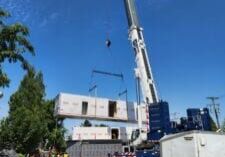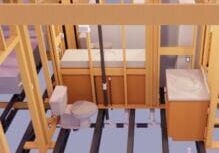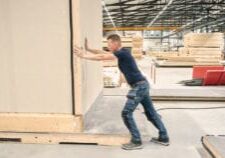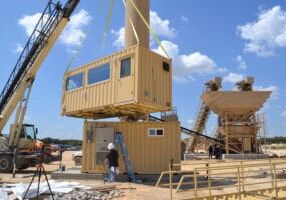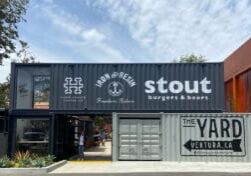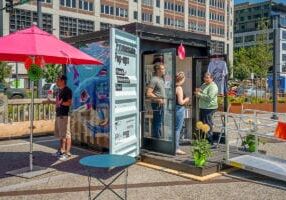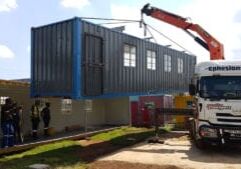From Ship to Shop: Repurposed for Retail
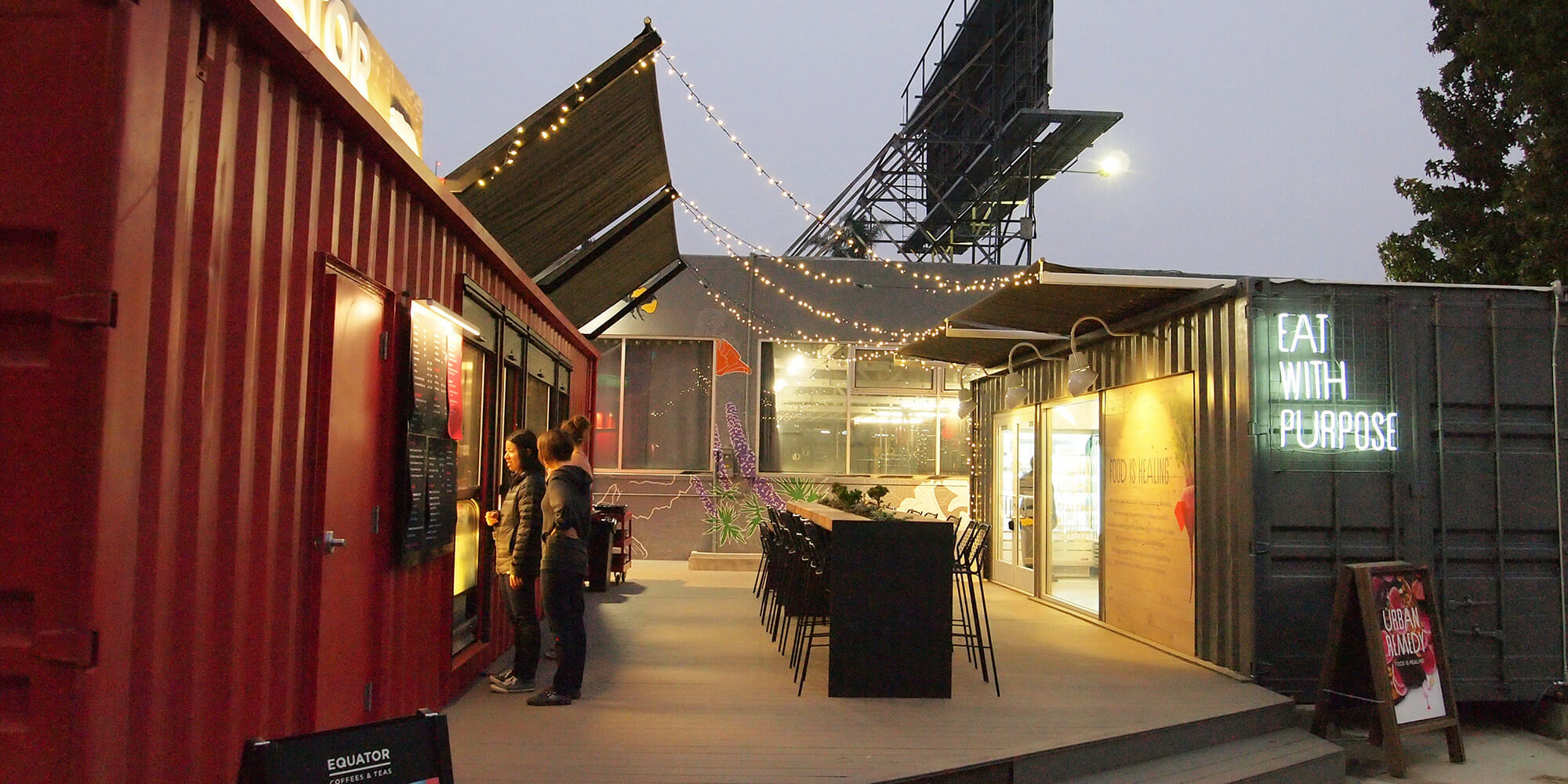
Harrison Street Oasis, located in Oakland, CA, aimed to provide a home for two emerging and local retail brands, Equator Coffee-a premium coffee retailer-and Urban Remedy- a boutique health food and beverage store-with a rapidly transforming downtown urban location.
The project developer saw an opportunity to transform a tiny backyard space of a remodeled building into a raised courtyard flanked by two custom commercial modular units fabricated from repurposed shipping containers. The retail units focus their energy into the public courtyard creating an intimate gathering space with tables, chairs, and shade structures to provides a welcome oasis for customers and residents alike.
The project was embraced by the City of Oakland and its residents, who have embraced ideas like ‘Urban Acupuncture.’ The utilization of “forgotten corners” in dense, urban locations to create intimate human-scale amenities that provide life and security to the streets has become a model for many other projects currently in the works.
The project was built by UrbanBloc, Inc. a northern California based container modification company, with design and engineering performed by R & S Tavares Associates. This 570 sq. ft. project took just over 100 days to complete.
Both units were constructed to become models for future roll-outs. Studies and tests were conducted both digitally and on the factory floor with the clients to define retail environment, workflow efficiency, and optimal customer and staff interactions.
Custom requirements and tolerances for equipment and infrastructure within such a constrained envelope that needed to be integrated within the overall fabrication system and then finished to an extremely high-aesthetic fit and build quality. The units were constructed to be Plug-and-Play site ready, with only foundation and utility connections in the field. All finishes and assemblies were required to withstand the flex of road transportation yet be seamless and tight as required by Environmental Health standards for food use.
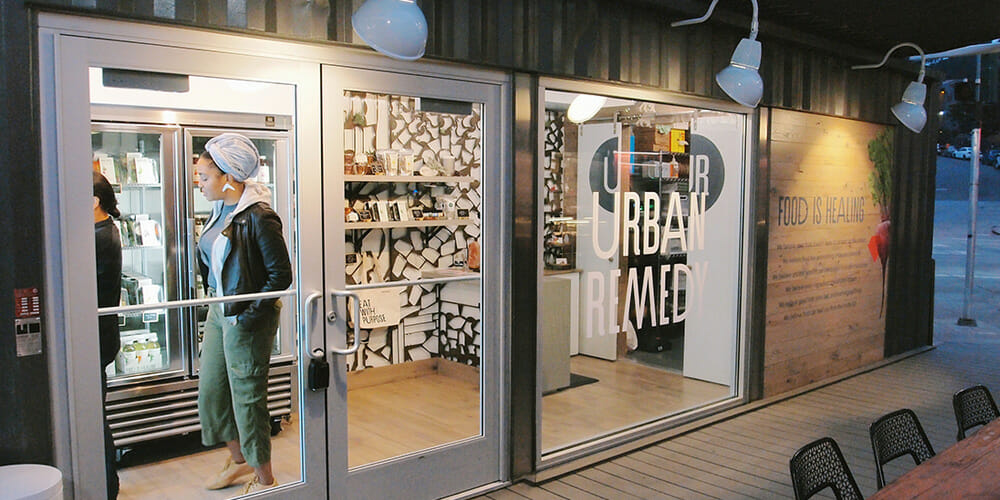
Cost Effectiveness
In comparison to brick and mortar build-outs, the clients report a savings of around 50%. This is partially in design/ build costs and partially due to the revenue generation as a result of the extremely quick timeline. Looking at future projects, the savings are expected to be even greater as the prototyping efforts, permitting and production layouts have been already invested in the units and captured by our procedures.
“We see the use of modified shipping containers as building components growing in the near future,” said MBI Executive Director Tom Hardiman. “That is one of the reasons we worked with the International Code Council to develop more resources for developers and code officials interested in this process.”
This article originally appeared in the Modular Advantage Magazine - Second Quarter 2019 released in May 2019.
More from Modular Advantage
AI, Faster Sets, and Automation: The Future of Modular is at World of Modular
While the modular building industry has long known that it can be an effective solution to increase affordable housing, the word is slowly spreading to more mainstream audiences. Three presentations at this year’s World of Modular in Las Vegas hope to provide insight and direction for those seeking a real solution to the crisis.
An Insider’s Guide to the 2025 World of Modular
The Modular Building Institute is bringing its global World of Modular (WOM) event back to Las Vegas, and with it comes some of the industry’s best opportunities for networking, business development, and education. Over the course of the conference’s four days, there will be numerous opportunities for attendees to connect, learn, and leverage event resources to get the most out of the conference.
Affordable Housing Now: The Industry’s Best Bring New Solutions to World of Modular
While the modular building industry has long known that it can be an effective solution to increase affordable housing, the word is slowly spreading to more mainstream audiences. Three presentations at this year’s World of Modular in Las Vegas hope to provide insight and direction for those seeking a real solution to the crisis.
Opportunities for Innovation in Modular Offsite Construction
Modular Offsite Construction has already shattered the myth that it only produces uninspired, box-like designs. Architectural innovations in module geometry, configurations, materials, and products make it possible to create visually stunning buildings without sacrificing functionality or efficiency.
Safe Modular Construction with Aerofilm Air Caster Transport
In collaboration with Aerofilm Systems, Heijmans developed innovative skids using air caster technology for moving modules easily and safely. These pallets are equipped with an auto-flow system, making operation extremely simple.
Miles, Modules, and Memes: Building a Modular Network One Flight at a Time
At the end of the day, social media is just another tool for building connections, and like any other tool, needs to be used skillfully to work properly. Use social media thoughtfully, and it will open doors to real opportunities and relationships you didn’t even see coming.
Falcon Structures: Thinking Inside the Box
Some of Falcon’s latest projects include creating container solutions for New York’s Central Park and an East Coast professional baseball team. More and more, Falcon is shipping out container bathrooms and locker rooms to improve traditionally difficult work environments, like those in oil and gas or construction.
UrbanBloc—From Passion to Industry Leader
UrbanBloc specializes in three main categories or markets – what they call “Phase 0” projects, amenities, and urban infill. Clients are often attracted to shipping containers because from a real estate perspective they are considered an asset. Having the flexibility to move and transport these assets allows owners to respond to different circumstances in a fluid manner that they can’t get with standard construction.
The Hospitality Game-Changer
“Hospitality is about more than just providing a service – it’s about delivering an experience,” says Anthony Halsch, CEO of ROXBOX. “And that’s where containers thrive. They allow us to create spaces that are unique, efficient, and sustainable.”
Container Conversions Counts on Simplicity to Provide Critical Solutions
Container Conversions has fabricated and developed thousands of containers for varied projects, including rental refrigeration options, offices, kitchens, temporary workplace housing, and mobile health clinics.



